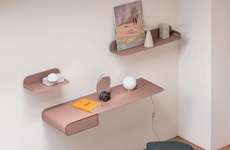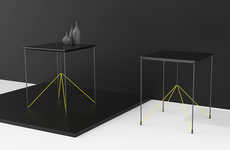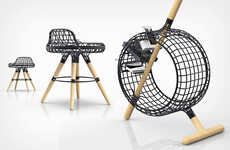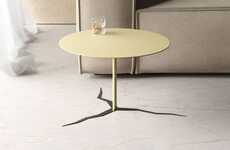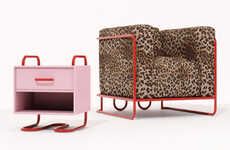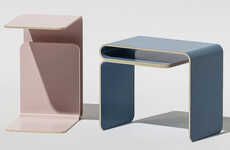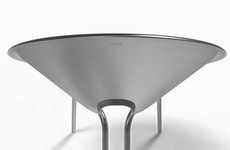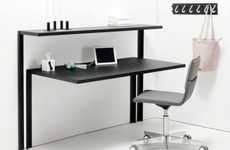
Tilt Furniture Offers Literal Flexibility in the Contemporary Home
Amelia Roblin — February 12, 2013 — Art & Design
References: tinaschmid.de & dezeen
With no other object in the image to give you a point of reference, take a look at these pieces of Tilt furniture. They look three-dimensional, don't they? If you could get up close to them and walk around them, however, you'd discover that they are incomplete frames of rectangular prismic volumes.
Only eight rods compose each of the two trompe l'oeil creations, meaning that only three sides of the shapes are suggested with contouring lines. What makes things more confusing is that the joints between them are flexible, enabling the objects to be manipulated for an increasingly mind-bending optical illusion.
Tina Schmid's Tilt furniture might not immediately tell of its purpose, but each has a primary one. The teal piece with its one wooden panel can become a wall-leaning table and the black one folds open to become a wall-mounted clothes rack.
Only eight rods compose each of the two trompe l'oeil creations, meaning that only three sides of the shapes are suggested with contouring lines. What makes things more confusing is that the joints between them are flexible, enabling the objects to be manipulated for an increasingly mind-bending optical illusion.
Tina Schmid's Tilt furniture might not immediately tell of its purpose, but each has a primary one. The teal piece with its one wooden panel can become a wall-leaning table and the black one folds open to become a wall-mounted clothes rack.
Trend Themes
1. Wireframe Illusion - Creating furniture using perceived 3D shapes and manipulatable flexible components opens up opportunities for complex visual designs.
2. Multi-functional Furniture - Designing furniture that can transform into different functional objects can lead to space-saving and practical solutions for interior design.
3. Minimalist Design - Using a simplistic approach to design furniture using only a few basic components can lead to unique and visually interesting products that challenge traditional furniture design.
Industry Implications
1. Furniture Design - Furniture designers can create visually complex and inventive products by utilizing manipulatable wireframe designs.
2. Interior Design - Interior designers can create space-saving and multifunctional living spaces by incorporating versatile furniture pieces into their designs.
3. Art and Sculpture - Artists and sculptors can push the boundaries of traditional design by incorporating optical illusions and a minimalist aesthetic into their works.
3.1
Score
Popularity
Activity
Freshness

